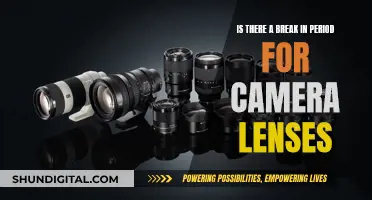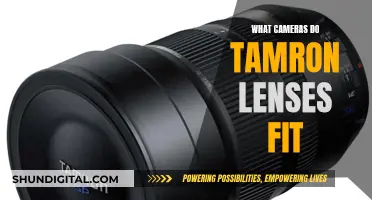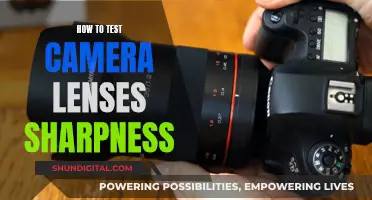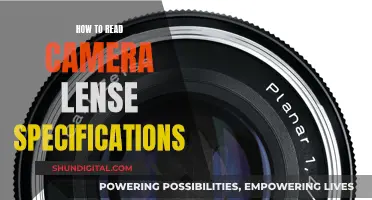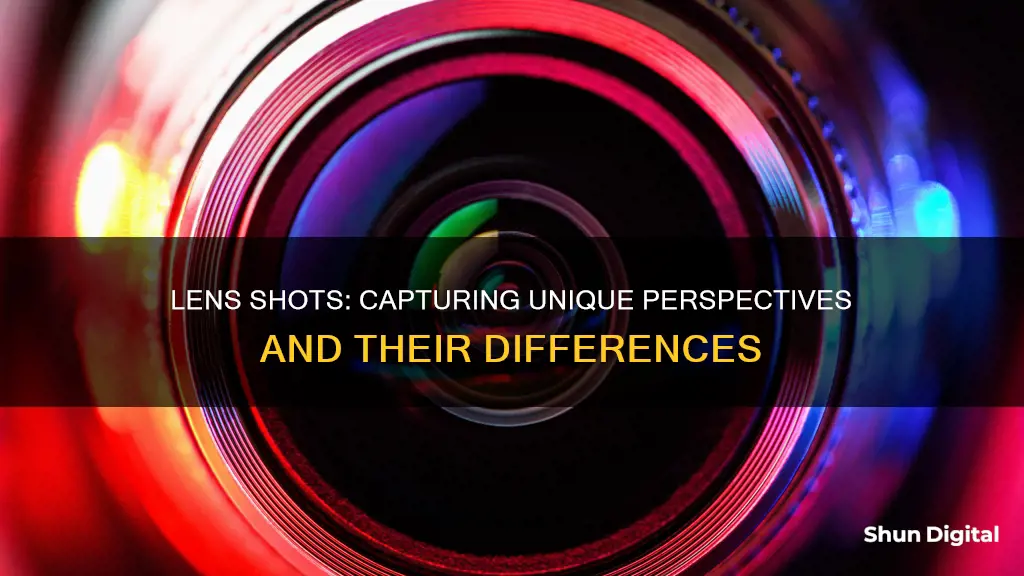
Camera lenses are essential to photography, and there are many different types, each with its own unique characteristics and uses. The two main categories of lenses are prime and zoom. A prime lens has a fixed focal length and tends to be lighter and cheaper, whereas a zoom lens has a variable focal length and is more versatile and convenient but usually more expensive.
Within these categories, there are several types of lenses. A standard lens has a mid-range focal length and offers a similar viewpoint to the human eye, making it a popular choice for street, portrait, and travel photography. A telephoto lens has a long focal length and is ideal for capturing distant subjects, making it popular for sports and wildlife photography. A wide-angle lens has a short focal length and a broad field of view, making it essential for landscape and architecture photography. An ultra-wide-angle or fisheye lens has an even shorter focal length, offering an extremely wide field of view but with a warping effect, making it a creative choice for fine art and extreme sports photography. A macro lens is designed for extreme close-ups, capturing tiny objects in sharp detail, and is commonly used for nature, product, and fine art photography. Finally, a tilt-shift lens can be tilted and shifted to manipulate the perspective and reduce distortion, and is often used in architecture and fine art photography.
| Characteristics | Values |
|---|---|
| Type | Prime, Zoom, Wide Angle, Telephoto, Super-Telephoto, Macro, Tilt-Shift, Fisheye |
| Focal Length | Variable or fixed |
| Aperture | Variable maximum aperture, wider maximum aperture |
| Weight | Lighter, heavier |
| Cost | Cheaper, more expensive |
| Use | Street, travel, portrait, landscape, architecture, sports, wildlife, action, close-up, astro-photography |
| Image Quality | Higher, lower |
| Flexibility | More, less |
What You'll Learn

Prime vs Zoom lenses
Prime Lenses:
Prime lenses have a fixed focal length, meaning the photographer cannot zoom in or out. They are classic lenses that have been around as long as cameras and are known for producing high-quality images. Prime lenses are often smaller, lighter, and more affordable than zoom lenses. They are ideal for specific types of photography, such as portraits, where the focal length matches the human eye's perspective. A standard prime lens has a focal length of 50mm.
Zoom Lenses:
Zoom lenses offer a variable focal length, allowing photographers to change their composition by zooming in and out. They are incredibly versatile and commonly used by wedding photographers. Zoom lenses are bulkier and heavier than prime lenses, and they might not produce the same image sharpness. However, they are highly convenient when photographers need to adapt to different situations without physically moving.
Advantages of Prime Lenses:
- Prime lenses are generally more affordable, with lower-priced options offering excellent optics.
- They are smaller, lighter, and easier to carry around.
- Prime lenses often provide sharper images and better low-light performance due to their larger maximum aperture, which also results in a shallower depth of field.
- Using a prime lens can help photographers develop their composition skills as they need to "zoom with their feet," finding new angles and perspectives.
Advantages of Zoom Lenses:
- Zoom lenses offer unparalleled versatility, allowing photographers to quickly switch between wide-angle and telephoto shots without changing lenses.
- They are ideal when photographers are restricted to a particular spot and need to adapt their framing accordingly.
- Zoom lenses often feature image stabilization technology, which helps capture sharp images in low-light conditions, even with slower shutter speeds.
- A single zoom lens can replace multiple prime lenses, reducing the need to carry multiple lenses and decreasing the risk of sensor dust when changing lenses.
The choice between a prime and a zoom lens depends on the photographer's needs and preferences. Prime lenses offer superior image quality, larger apertures, and better low-light performance, whereas zoom lenses provide unmatched versatility and convenience. Budget, shooting style, desired focal lengths, and physical constraints also play a role in the decision-making process. Ultimately, both types of lenses have their advantages and can produce amazing images in the right hands.
Double Lens Cameras: More Accurate or Just a Gimmick?
You may want to see also

Wide-angle lenses
A wide-angle lens generally has a focal length between 16 and 35mm, with anything below 35mm considered a wide-angle lens. Focal lengths between 35mm and 24mm are considered standard wide angles, while those between 24mm and 16mm are wide angles, and anything below 16mm is considered an ultra-wide angle. The most popular wide-angle zoom range is 16-35mm.
One unique feature of wide-angle lenses is that they distort things and enhance perspective. Objects closer to the camera appear larger than those farther away, even if they are the same size in reality. This can be used creatively when composing images, but it also means that wide-angle lenses are not typically used for portraits, as they can distort the subject's features and be unflattering.
Another thing to keep in mind when using a wide-angle lens is that they can cause converging verticals. When the lens is pointed above or below the horizon, parallel vertical lines will appear to converge. This effect is generally avoided in architectural photography but can be used creatively in other types of photography.
When using a wide-angle lens, it's important to have a clear subject in the image and not try to fit too much into the frame. Get close to your subject and use foreground elements to add depth and guide the viewer's eye.
Understanding the Versatile 18-55mm Camera Lens
You may want to see also

Telephoto lenses
A telephoto lens has a longer focal length than a standard lens, yielding a magnified image and a narrow field of view. A telephoto lens allows you to photograph a subject that is far away. Typically, a lens is considered "telephoto" if its focal length is 60mm or longer. However, some sources state that a telephoto lens has a focal length of 70mm or longer.
There are three main types of telephoto lenses:
- Short telephoto lens: 85mm to 135mm in 35mm film format
- Medium telephoto lens: 135mm to 300mm in 35mm film format
- Super telephoto lens: over 300mm in 35mm film format
The Importance of Pristine Camera Lenses for Perfect Pictures
You may want to see also

Super-telephoto lenses
When choosing a super-telephoto lens, it is important to consider the sensor size, as APS-C and Micro Four Thirds cameras have crop factors that will effectively increase the equivalent focal length. The aperture is also a key feature, with faster apertures being larger and more expensive. Image stabilisation is another important feature, especially when handholding the lens, as it helps to reduce camera shake.
Some popular super-telephoto lenses include the Canon RF 600mm f/11 and RF 800mm f/11 IS STM, the Sony FE 400mm f/2.8 GM OSS and FE 600mm f/4 GM OSS, and the Sigma 150-600mm f/5-6.3 DG DN OS Sport. These lenses offer a range of focal lengths, apertures, and features to suit different needs and budgets.
Sigma Lenses: Compatibility Across Camera Brands
You may want to see also

Macro lenses
The key advantage of macro lenses is their ability to reproduce small subjects at life-size or larger. This makes them ideal for photographing insects, flowers, jewellery, and other small objects in extreme close-up. They are also useful for newborn photography, capturing tiny details with exceptional clarity.
It's worth noting that while there are zoom macro lenses available, prime macro lenses are generally considered superior for achieving true macro results due to their fixed focal length. Additionally, some lenses marketed as "macro" may not offer a high enough magnification ratio to be considered true macro lenses, so it's important to check the specifications before purchasing.
Another important characteristic of true macro lenses is their "flat-field" design. This means that the plane of focus is flat, ensuring that the entire image is in sharp focus. Non-macro lenses often have a curved field, resulting in softer edges or corners.
While macro lenses are specialised tools, they can be used for more than just extreme close-ups. They can be useful for portraiture, product photography, and even landscapes. The ability to focus at very short distances and capture fine details makes macro lenses a versatile addition to any photographer's kit.
Large Camera Lenses: Capturing the Bigger Picture
You may want to see also
Frequently asked questions
Camera lenses can be split into two main categories: prime and zoom.
Prime lenses have a fixed focal length and tend to be lighter, cheaper, and of better optical quality. Zoom lenses, on the other hand, have a variable focal length, allowing you to zoom in and out, but are usually heavier and more expensive.
Examples of prime lenses include the Nikon NIKKOR Z 35mm f/1.8 S and the Canon EF 50mm f/1.8 STM. Examples of zoom lenses include the Sony FE 24-70mm f/2.8 GM II and the Canon EF-S 18-55mm f/3.5-5.6 IS II.



